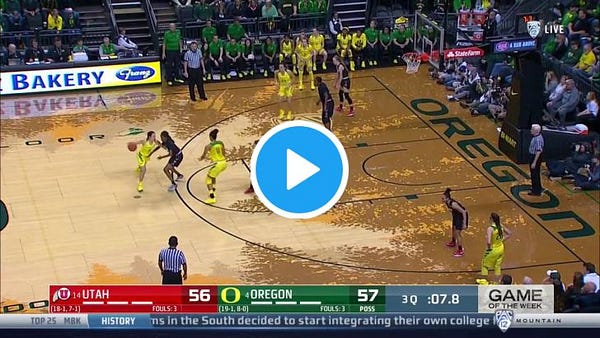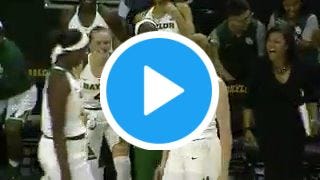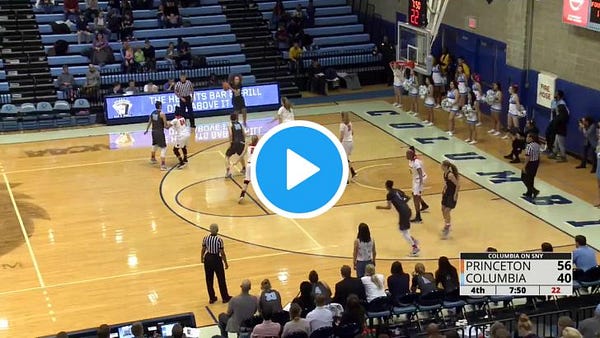Thanks for reading the Her Hoop Stats Newsletter. If you like our work, be sure to check out our stats site, our podcast, and our social media accounts on Twitter, Facebook, and Instagram. You can also buy Her Hoop Stats gear, such as laptop stickers, mugs, and shirts!
Haven’t subscribed to the Her Hoop Stats Newsletter yet?
Actual games are on hold, but when it comes to the draft, the show must go on (virtually, of course).
The fan bases of the WNBA and Division I have a ton of overlap, but for WNBA fans who have yet to dip their toes in the college game, the draft may be the first introduction to these young talents. So what are these soon-to-be rookies bringing to the table? Those that get selected in the first round of a professional sports draft are generally multi-talented, but if we listed everything each player excels at you’d probably still be reading this when the draft starts on Friday. So we’ll stick with one strength for each.
Here is one skill that each of the top 12 in Mechelle Voepel’s latest mock draft will bring to her new team.
Sabrina Ionescu: pick-and-roll game
Okay, even those who have never seen a second of college hoops probably know who Sabrina is. There's a reason No. 20 headlines the class of ‘20. Actually, there are 2000+1000+1000 reasons. But the number of them that immediately grab the eye is the same as the number of stat categories in which she routinely posts double figures: three.
pick
and
roll
Three is also the number of meals a day for which she eats ball screen coverages. According to Synergy, Oregon scored 465 points when Sabrina was the ball handler on a pick-and-roll this season. No other team—across all three divisions—even scored 400 with the same handler, and only eight made it to 300. The scariest part? The volume didn’t come with a sacrifice in efficiency. The Ducks scored 1.11 points per possession on her 419 pick-and-rolls, which was second in Division I with a minimum of just 110 possessions. Ionescu’s new team (let’s call a spade a spade: the Liberty) will be getting a point guard who can pick apart defenses with her ability to read ball screens.
Satou Sabally: slashing
As dominant as Ionescu is, she did have some help in Eugene. Sabally is what folks in the business might call a matchup nightmare: a 6-foot-4 forward who does guard things. She slashes, she cuts, and she can even dish it a little and knock it down from the outside if she’s open. The most developed of these skills thus far is her ability to put the ball on the floor. Sabally will give opposing coaches fits as they try to figure out who to stick on her. A guard who can stay in front? Or a post who can match her size?
Lauren Cox: shot blocking
It was a weird year for Baylor’s hometown hero. When the season began, there was a semi-real Sabrina vs. Cox debate for various player of the year awards. After an injury limited Cox to just two games prior to New Year’s Eve, the senior was human on offense—her 0.97 points per scoring attempt was a career low. The defense returned, however, and Cox averaged over 2.5 blocks per game for the third straight season. Cox’s new squad will be adding a human eraser. And not just around the basket either. She’s been doing this since she set foot in Waco her freshman year:
Chennedy Carter: one-on-one scoring
Like Cox, Carter missed several games due to injury this season. Unlike Cox, Carter is best with the ball in her hands. The nation's sixth-leading scorer is a bonafide bucket-getter—the type coaches can give the ball to in a tie game with the shot clock off. She's a three-level scorer and a high-level one-on-one machine. Carter can break down her defender and light up the scoreboard (and yeah, she’s even done it against Team USA already).
Tyasha Harris: passing
Many of Harris’ skills are, well, a little bit boring. The type that are, almost by definition, hardly prone to make SportsCenter's Top Ten. Take, for example, her leadership, or her bank-level ball security. You want a highlight of Harris not turning the ball over? Go watch basically every possession of Gamecock basketball.
There is one flashy aspect to her game though: passing. Yeah, she's a point guard, so she's supposed to pass well. But you don't lead the SEC in assists just by playing the right position. Harris is a high-IQ floor general who is equally adept at running half-court offense and running the break.
Megan Walker: shooting
Geno Auriemma has a history of pumping out WNBA All-Stars. Lobo. Bird. Taurasi. Charles. Moore. Stewart. Collier.
Walker?
That remains to be seen, but what doesn’t is Walker’s shooting ability—the junior made 2.4 threes per game last season on over 45% shooting from deep. She’ll have to take a step back in the league—a 16.75-inch step to be exact—but that shouldn’t be too much of a problem. Walker will stretch the floor for whichever team picks her up on Friday night.
Bella Alarie: shooting
It admittedly feels a little awkward choosing the same skill for Alarie as for Walker—the two are very different players, and Walker shot a higher percentage from three in each of the three seasons they were both in college. But Alarie does it with four extra inches and 39 extra blocks. Watch her seamlessly transition from rim protector to three-point threat in the same sequence:
Alarie is a skilled forward who is made for today’s game. Once called unicorns, stretch bigs have become a virtual staple in modern offenses. She’ll most likely play the three and the four, but with her ability to protect the rim don’t count her out as a small-ball five in certain lineups.
Kiah Gillespie: rebounding
No one in the ACC grabbed more defensive rebounds over the last two seasons than Kiah Gllespie. After fizzling out at Maryland, the move to Tallahassee did wonders for Gillespie (and it worked out pretty well for the ‘Noles as well). The Connecticut native was a force in her junior and senior seasons, averaging over nine rebounds a game across 65 games. The naysayers might point to her height—it’s not unreasonable to call her undersized as a 6-2 power forward—but rebounding against taller competition takes a want-to, and it’s that nonstop effort that her new team will appreciate the most.
Joyner Holmes: strength
Is strength a strength? For Joyner Holmes it is. The former top-two prospect (how was Sabrina only No. 4 in that class??) had an up-and-down college career, although it might be more accurate to call it “down-and-up” considering how it ended. She fell off the map early on, but Holmes’ standout senior campaign has her back in first-round conversations, and rightfully so. The 6-3 forward has a pro-ready physique and will be a load in the league. Check out Justin Carter’s breakdown of her game—those are some strong finishes around the rim in his first two clips. Her strength doesn’t seem to slow her down too much either—she might not be Satou Sabally, but her speed and skill at her size still have scouts salivating.
Beatrice Mompremier: transition
When you talk about Mompremier’s speed, you can forget the “at her size” qualifier. She’s just plain fast. Her late-season injury might be what keeps her out of the top half of the first round, but the team that ends up with her will be getting a 6-4 cheetah with post moves. It’s not just the scouts enthralled by the Miami product’s potential—any guard would love to run with a big like Beatrice. If you’re a police officer in the city in which she lands, get ready to hand out some speeding tickets.

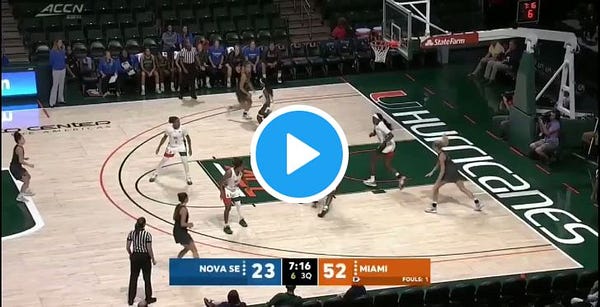
Ruthy Hebard: post scoring
Really, really, really efficient post scoring, that is. Hebard has ranked in the top five of all power conference players in points per scoring attempt for three straight seasons, never finishing below 1.35 during that time. She was also mere decimals away from leading the nation in field goal percentage this year—her 68.48% trailed only Kiara Williams of Arkansas (68.52%). That was after finishing second in her junior season as well, behind AP Player of the Year Megan Gustafson. If Hebard’s new teammates can get her the ball in the paint, she’ll do the rest.
Te’a Cooper: versatility
If you think choosing "versatility" as one skill is just a copout for talking about several skills, you're right. Cooper can run the point or play the two, she can get to the rim or find her teammates, she can lock down on the perimeter, and she even added a three-point stroke this season. It surely helped that she moved to a new environment in Baylor in which lots of defensive attention went to the post, but after failing to shoot even 30% from behind the arc in any previous season, the combo guard knocked down 41.5% of her triples in her final year. Wherever Cooper goes, she will bring a wealth of basketball gifts with her.
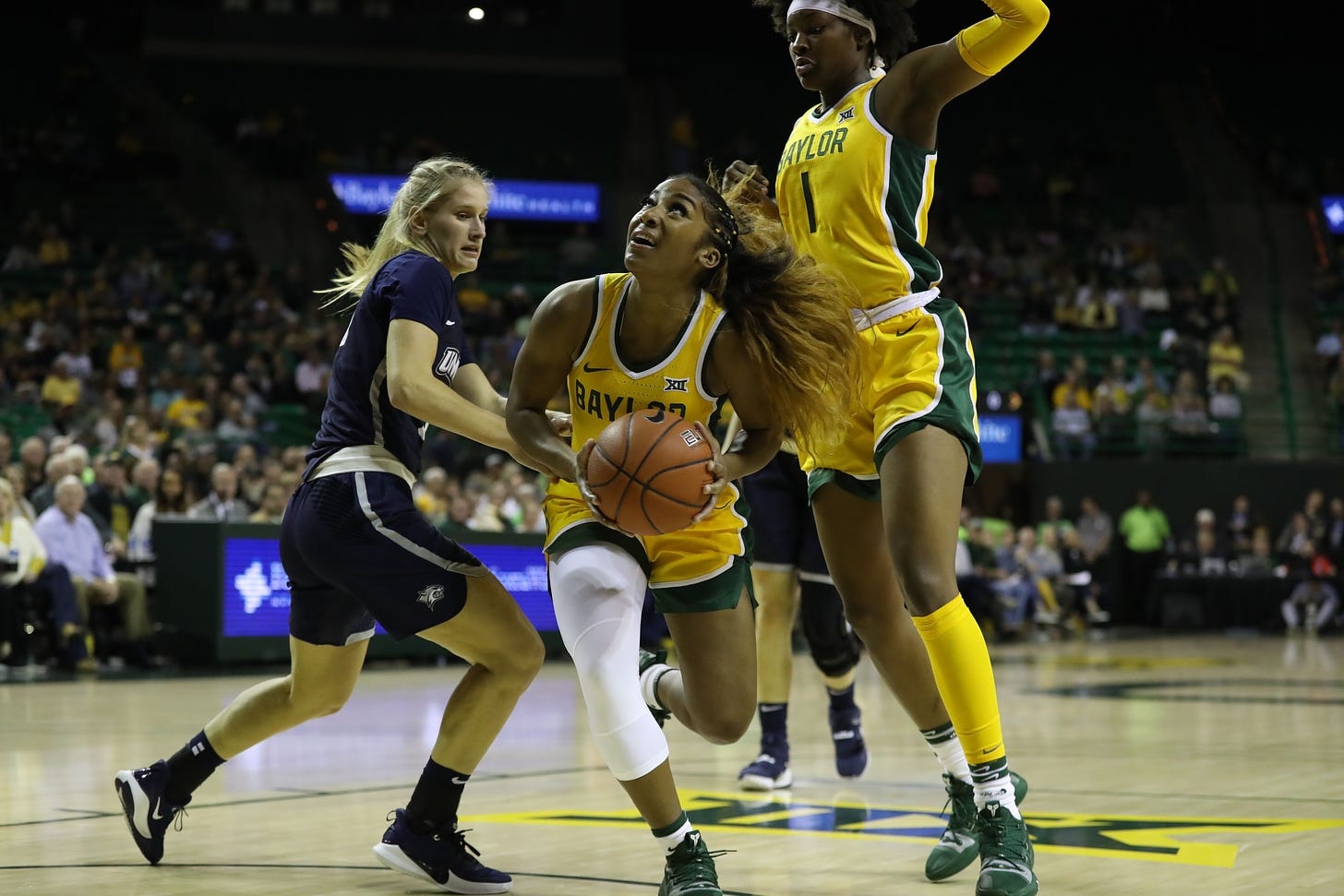
Te’a Cooper looks to score against New Hampshire in an opening-day contest on Nov. 5, 2019. Photo courtesy of Baylor Athletics.
Thanks for reading the Her Hoop Stats Newsletter. If you like our work, be sure to check out our stats site, our podcast, and our social media accounts on Twitter, Facebook, and Instagram. You can also buy Her Hoop Stats gear, such as laptop stickers, mugs, and shirts!
Haven’t subscribed to the Her Hoop Stats Newsletter yet?





